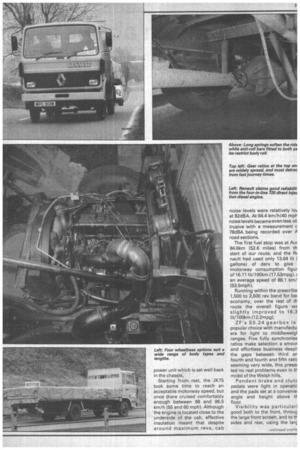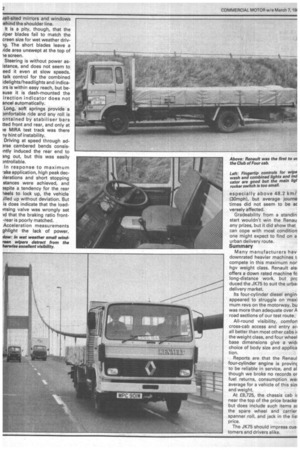Frenchman about town
Page 32

Page 33

Page 34

If you've noticed an error in this article please click here to report it so we can fix it.
'URPOSE-BUILT for urban devery operations, Renault's fourylinder JK75 has a maximum ross weight of 7.38 tons, which leans it can be driven by nongv drivers; and four wheelbase imensions are said to include le shortest and the longest ffered by any manufacturer at us weight. Renault's other 7.5)nner — the JN 75 — is a ownrated nine-tonner, quipped with a six-cylinder enme and normally specified for unking work, but the Renault 20 engine gives the JK75 a omparatively low installed ower output of 64kW (86bhp). owever, when specified with a nal drive ratio of 4.55 to 1, the istest of three options, it has a laximum geared speed of 1.4km/h (59.9mph).
Our test vehicle had a 3.85m 2ft 7.5in) wheelbase, providing ir a body/payload weight of 995 tonnes. The 5.84m (19ft n) all-aluminium dropside )dy from Vaile & Company of turminster Newton in Dorset led to our Renault gave a 3yload potential of approxiately 4.45 tonnes, and the ad height is contained to a )mfortable 1.06m (3ft 6in).
The cab is the result of a joint :nture by the Club of Four laviem, DAF, Magirus and Volvo) are first used by Renault for its J-Series 9-, 11and 13tonnes gvw models six years ago.
For the smaller JK75 the same high standard of finish has been maintained both inside and out, and the design makes use of the hollow beam technique consisting of panels swaged to form hollow, light but strong rigid sections.
Doors open to 90° and a low entry is provided by wide nonslip steps and grab handles each side. Across-cab movement is only slightly restricted by a gearlever which protrudes above squab height. A non-suspension cloth-covered drivers' seat gives plenty of adjustment in all directions as well as angled adjustments to the squab and back rest. But if required, a suspension-type seat is available. To the near side, a bench-type seat provides comfortable seating for two passengers.
Air vents are located at each end and at the centre of the dash, there's a good-sized lockable glovebox, and heating controls are easy to operate. With a total of 14 warning lights, the instrument binnacle is inevitably crowded, but all can be easily seen.
A hazard warning-light switch is centrally mounted and surrounded by three gauges which monitor fuel levels, oil pressure and engine temperature, while a fourth, an air-pressure guage, in dicates the output from the compressor, not the air-reservoir pressure. A separate warning lamp is included to show minimum pressure.
With the rev counter and the now obligatory tachograph, 34 functions are grouped together directly in front of the driving position.
The floor is neatly covered in rubber matting which comes flush to the door openings. A large front screen extends from below facia level to roof height and is complemented by windup door windows, quarter lights behind the B-post, and rear panel windows making the light trim even brighter.
For daily checks, oil and coolant levels are at the rear of the cab, but on opposite sides and a windscreen-washer bottle is located at the front beneath grille. Battery and brake fluid rE servoirs are mounted further t the rear on the nearside of th chassis. All are easily accessibl but could be better grouped tc gether.
Should the engine need close attention, the cab can be tilt& manually to 52° and nothing ha to be disconnected as the gea linkage is telescopic. Pivo points are placed well forwan giving good clearance to thi power unit which is set well back in the chassis.
Starting from rest, the JK75 took some time to reach an acceptable motorway speed, but once there cruised comfortably enough between 88 and 96.5 km/h (55 and 60 mph). Although the engine is located close to the underside of the cab, effective insulation meant that despite around maximum revs, cab noise levels were relatively lo% at 82dBA. At 64.4 km/h(40 mph noise levels became even less ot trusive with a measurement c 78dBA being recorded over A road sections.
The first fuel stop was at Aw 84.6km (52.6 miles) from th start of our route, and the RE nault had used only 13.64 lit ( gallons) of dery to give motorway consumption figur of 16.11 lit/100km (17.53mpg), 2 an average speed of 86.1 km/ (53.5mph).
Running within the prescribe 1,500 to 2,500 rev band for be economy, over the rest of th route the overall figure WE slightly improved to 16.3 lit/100km (12.2mpg).
ZF's S 5.2 4 gearbox is popular choice with manufactu ers for light to middleweigl ranges. Five fully synchronise ratios make selection a smool and effortless business despil the gaps between third an fourth and fourth and fifth ratic seeming very wide, this presei ted no real problems even in if midst of the Welsh hills.
Pendent brake and clutc pedals were light in operatic and the pads set at a conveniel angle and height above th floor.
Visibility was particularl good both to the front, throug the large front screen, and to tF sides and rear, using the lar,c rell-sited mirrors and windows ehind the shoulder line.
It is a pity, though, that the tiper blades fail to match the creen size for wet weather drivlg. The short blades leave a tide area unswept at the top of le screen.
Steering is without power asstance, and and does not seem to eed it even at slow speeds. talk control for the combined idelights/headlights and indica)rs is within easy reach, but beuse it is dash-mounted the irection indicator does not ancel automatically.
Long, soft springs provide a Dmfortable.ride and any roll is
ontained by stabiliser bars tted front and rear, and only at ie MIRA test track was there ly hint of instability.
Driving at speed through adarse cambered bends consis intly induced the rear end to ang out, but this was easily mtrollable.
In response to maximum 'eke application, high peak dec )lerations and short stopping stances were achieved, and aspite a tendency for the rear 'eels to lock up, the vehicle ailed up without deviation. But is does indicate that the loadinsing valve was wrongly set id that the braking ratio front-rear is poorly matched. Acceleration measurements ghlight the lack of power,
plow: In wet weather small windreen wipers detract from the herwise excellent visibility.
especially above 48.2 km/ (30mph), but average journe times did not seem to be ac versely affected.
Gradeability from a standin start wouldn't win the Renau any prizes, but it did show that can cope with most condition one might expect to find on a urban delivery route.
Summary
Many manufacturers hay downrated heavier machines t, compete in this maximum nor hgv weight class. Renault alsd offers a down rated machine fo long-distance work, but prc duced the JK75 to suit the urbai delivery market.
Its four-cylinder diesel engin, appeared to struggle on maxi mum revs on the motorway, bu was more than adequate over A road sections of our test route.
All-round visibility, comfort cross-cab access and entry an all better than most other cabs ii the weight class, and four wheel base dimensions give a with choice of body size and applica tion.
Reports are that the Renaul four-cylinder engine is provinc. to be reliable in service, and al though we broke no records or fuel returns, consumption wa: average for a vehicle of this size and weight.
At E8,725, the chassis cab near the top of the price bracke. but does include such items a: the spare wheel and carrier spanner roll, and jack in the list price.
The JK75 should impress customers and drivers alike.
























































































































